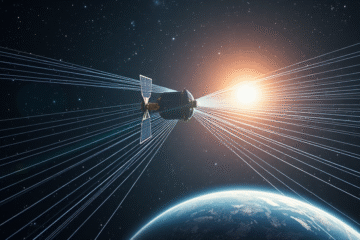Unexpected Discoveries in Saturn's Atmosphere
Saturn's atmosphere It is a fascinating mystery that has recently taken on new dimensions with the discoveries made by the James Webb Space Telescope.
Scientists have identified unexpected patterns and complex structures in the planet's upper layers, revealing an intriguing region known as the ionosphere, located 1,100 kilometers above the clouds.
This new information not only expands our understanding of Saturn's atmospheric dynamics, but also opens the door to future investigations into the interactions between its magnetic field and atmosphere, highlighting the importance of continuing to observe this gas giant and its peculiarities.
Discovery of Unexpected Patterns in Saturn's Upper Atmosphere
The recent discovery of unexpected patterns in Saturn's upper atmosphere has revealed an unprecedented complexity not previously observed on other planets in the Solar System.
Thanks to the advanced James Webb Space Telescope, scientists have identified intriguing structures in Saturn's ionosphere, detailing magnetic interactions that challenge current understanding of the gas giants' atmospheric dynamics.
These discoveries not only expand our knowledge of Saturn, but also have the potential to transform how we understand other gas planets in our universe.
Saturn's Ionosphere 1,100 Kilometers Above the Clouds
The James Webb Space Telescope has revealed fascinating details about the ionosphere of Saturn, a electrically charged layer, located 1,100 kilometers above the planet's clouds.
Using advanced technology, the scientists have managed to identify and observe this region in detail, highlighting its unique asymmetric structure.
That layer is crucial for the circulation of particles, influenced by the planet's magnetic field.
During 10 hours of observation, the team detected H₃⁺ ions, whose presence points to complex interactions between space and Saturn's upper atmosphere.
Asymmetric Star-Shaped Structure
It was like watching a celestial beacon slowly blinking in the ionized fog.
, comments astrophysicist Ana Silva about the asymmetrical star discovered in Saturn's ionosphere by the James Webb Space Telescope.
This formation presents a stability of several hours, moving slowly in an environment still little understood by scientists.
This phenomenon suggests atmospheric processes unknown, possibly linked to the planet's magnetic field.
Studying these patterns will provide deeper understanding and new paradigms in planetary science.
To learn more, check out the full article on Super Interesting.
Atmospheric Dynamics and Interaction with the Magnetic Field
Recent observations of the James Webb Telescope highlight a unique dynamic between the magnetic field and Saturn's atmosphere, challenging known models.
The observed star formations reflect a complex magnetic-atmospheric coupling.
Imagine this interaction as an “invisible string pulling the charged fog,” where the ionospheric wind meticulously adjusts to the magnetic fluctuations.
This generates energy patterns that constantly reconfigure the planetary atmospheric structure.
In summary, these findings suggest:
- Electromagnetic coupling
- Energy transport
- Influence of solar particles
Future observations promise to deepen our understanding of this fascinating dynamic.
Scientific Team and Analysis Methodology
The team of 23 scientists dedicated themselves intensely to analyzing the data captured by James Webb Telescope, focusing on Saturn's atmospheric complexities.
For 10 consecutive hours, they immersed themselves in detailed data, applying a variety of methodologies to unlock the unknown subtleties of these mysterious formations.
The synergy between experts from different disciplines allowed not only the identification of structures, but also a deeper understanding of their potential impacts.
The team, comprised of astrophysicists, engineers, and meteorologists, exemplifies the importance of an interdisciplinary approach.
With the recent revelation of complex patterns such as asymmetric formations in the ionosphere, the findings highlight the potential impact of these observations on the physics of gas giants, paving the way for new lines of research.
| Specialty | Institution | Dedicated hours |
|---|---|---|
| Astrophysics | ESA | 10 am |
| Space Engineering | NASA | 9 am |
| Space Weather | Uni.
Northumbria |
8 am |
This collaboration reflects not only the dedication to the study of formations on Saturn, but also the possibility of significant developments in atmospheric understanding on other planets in the solar system.
Future observations, especially during seasonal transitions, could provide new insights that are essential for understanding the atmospheric dynamics of gas giants.
The research emphasizes untapped scientific potential, highlighting the need for continued investigations.
Future Perspectives During Saturn's Northern Hemisphere Seasonal Transition
The seasonal transition in Saturn's northern hemisphere involves changes in climate and atmospheric dynamics as the planet follows its long orbital cycle. As these changes become more pronounced, the James Webb Space Telescope is preparing to further analyze these transformations.
Scientific expectations are enormous, as the new observations promise to revolutionize our understanding of the circulation of energy between the different layers of Saturn's atmosphere.
With detailed studies of this transition, there is a chance to discover patterns that can elucidate how the planet's magnetic field interacts with its gaseous layers.
According to the article of the super interesting, these discoveries will provide valuable insights into previously unknown phenomena, opening new frontiers in gas giant science and potentially transforming current understanding of planetary atmospheric processes.
Recent discoveries about Saturn's atmosphere raise intriguing questions and challenges for science, emphasizing the need for more detailed observations.
The potential to redefine our understanding of gas giants is promising, especially with the upcoming seasonal transition.



0 Comments